Best aquarium plant fertilizers – Nutrients, deficiency symptoms, treatments
The process of growing plants inside an aquarium is pretty much the same as growing terrestrial plants. All plants have basic needs that must be met for them to thrive. These include oxygen, carbon dioxide, water, light, and some sources of nutrition. If you have a heavily planted aquarium, you should establish a fertilizing schedule to keep your plants healthy. Without enough CO2 and other essential nutrients, plant health may decline, and when unhealthy plants have to compete with algae for nutrients, your aquarium will ultimately deteriorate.
It’s important to learn how to apply plant fertilizers to aquatic plants if the plants are to flourish. In this guide, we’re going to look at the top aquarium plant fertilizers and root tabs available today. Before that, let’s first review the basic nutrients that aquarium plants need to survive.
- Notable macronutrients and micronutrients for plants
- [Comparison table] fertilizers and root tabs
- Best aquarium plant fertilizers reviewed
- Seachem Flourish freshwater plant supplement
- Seachem Flourish growth supplement tabs
- Thrive+ all-in-one liquid aquarium fertilizer
- Thrive S shrimp specific all-in-one aquarium fertilizer
- Seachem Flourish Excel bioavailable carbon
- NilocG Aquatics Liquid NPK+M aquarium fertilizer
- Fluval Plant Gro+ micronutrient for aquariums
- API root tabs freshwater aquarium plant fertilizer
- API leaf zone freshwater aquarium plant fertilizer
- API CO2 booster freshwater aquarium plant treatment
- Aquarium plant root fertilizer tabs, budget option
- Aqueon aquarium plant food
- Recommended water parameters and nutrient concentrations
- How to Properly Dose Aquarium Fertilizers
- Frequently Asked Questions
Notable macronutrients and micronutrients for plants
Macronutrients
Carbon (C)
Role of carbon:
All living things, including plants, are carbon-based. Carbon atoms bond with atoms of other elements to form fats, proteins, and carbohydrates that living things need for nourishment.
Plants use carbon in the form of carbon dioxide (CO2) gas through photosynthesis. Carbon dioxide is readily available in the aquarium. It enters the water from the atmosphere, through fish respiration, and other natural processes, such as when uneaten food breaks down on the soil substrate. However, if you want your planted tank to flourish, an external CO2 supplier is a must.
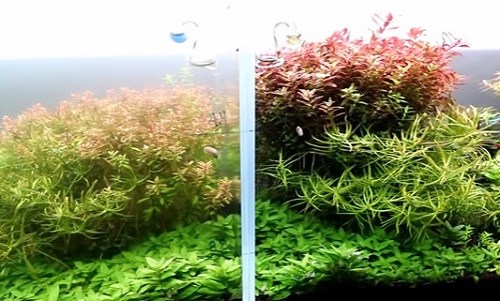 Left (without CO2 supplement), right (with CO2 supplement), after 40 days of trimming
Left (without CO2 supplement), right (with CO2 supplement), after 40 days of trimming
Signs of carbon deficiency:
- Slow growth
- Poor development of carpet plants
- Plant leaves lose colors
- Plants losing leaves and dying one by one
Solutions:
- Increase water aeration and surface agitation
- Pressurized CO2 systems
- Bioavailable carbon sources such as Seachem Flourish Excel #ad
- Add more fish.
Nitrogen (N)
Role of nitrogen:
Nitrogen is the element aquarium plants need the highest amount of next to carbon dioxide. It is used in a variety of organic compounds and is found in all amino acids. It is also essential to the formation of chlorophyll, nucleic acids, and plant hormones.
Aquarium plants cannot use nitrogen in the form of gaseous nitrogen or N2. Instead, they use nitrogen in the form of nitrate (NO3-) and ammonium (NH4+). These are products of the degeneration process of fish wastes and decaying matter in the aquarium. Therefore, planted aquariums with little to no fish may encounter nitrogen deficiency.
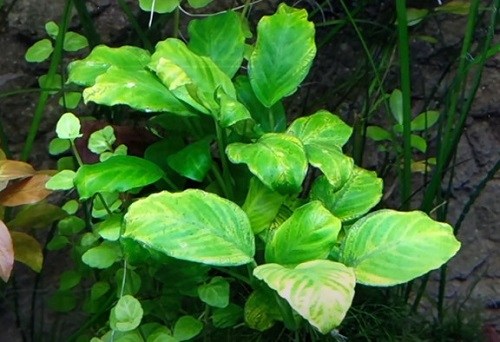 Nitrogen deficiency
Nitrogen deficiency
Signs of nitrogen deficiency:
- Slow growth
- Leaves turning yellow and translucent, especially older leaves
- New leaves will be smaller stunted or crippled growth
- Fuzz or hair algae
Solutions:
- Nitrogen supplement #ad
- Add more fish
Phosphorus (P)
Role of phosphorus:
Phosphorus comes in various organic and inorganic forms. It is absorbed by aquarium plants in the form of phosphate (PO4 3-). Phosphorus plays a crucial role in the formation of ATP (adenosine triphosphate) that provides energy for most living organisms. It is also a part of phospholipids and nucleic acids (DNA and RNA).
In planted aquariums, phosphate is produced via waste degradation. Heavily planted tanks with only a few fish are often deficient in phosphate.
Signs of phosphorus deficiency:
- Slow growth
- Leaves turning darker or purple in color
- Dead patches on older leaves because of phosphorus reabsorption
- Small and distorted new shoots
Solution:
Potassium (K)
Role of potassium:
Potassium is one of the three main nutrient elements for aquarium plants and is absorbed in the form of potassium cation or K+. Plants use potassium during photosynthesis. It plays a major role in plant metabolism and other biological functions. Compared to carbon, nitrogen, and other nutrients, potassium is highly soluble and is absorbed mainly through plant leaves.
Signs of potassium deficiency:
- Plant leaves turning yellow
- Perforated plant leaves
- Reduce plant growth
Solution:
Calcium (Ca)
Role of calcium:
Calcium is an essential phytonutrient that is absorbed by plants as Ca2+. It is vital for the development of cell walls and membranes in plants, as well as in cell division, carbohydrate metabolism, and conversion of nitrate.
Using soft or reverse osmosis (RO) water for your planted tank may result in calcium deficiency. To keep this from happening, it is recommended that you increase water hardness by adding crushed corals in the filter or substrate. The good news is that calcium deficiency is not a common problem in planted aquariums.
Signs of calcium deficiency:
- New plant leaves growing out twisted
- Stunted plant growth
- Tips of leaves withering
Solution:
- Use tap water instead of RO/DI water
- If using RO/DI water, remineralize it with Seachem Equilibrium #ad
- Increase water hardness by adding calcium carbonate substances such as crushed corals
Magnesium (Mg)
Role of magnesium:
Aquarium plants absorb magnesium in the form of Mg2+. Magnesium plays an integral role in photosynthesis and is also useful in the formation of proteins, DNA, RNA, fats, vitamins, and carbohydrates. It also plays a part in the activation of enzymes. While calcium is highly concentrated in the most mature parts of the plant, magnesium is found mostly in areas of plants that are just starting to grow or develop.
Signs of magnesium deficiency:
- Paling leaf tissue between normal dark veins on older leaves
- Crippled plant growth
Solution:
- Most aquatic plant fertilizers contain magnesium
- Use Epsom salt (magnesium sulfate)
- Add Seachem Equilibrium #ad
Other macronutrients that help in the development of plants including oxygen, hydrogen, and sulfur are readily available in tap water and soil. As for sulfur, it is absorbed by plants as sulfate and is essential for chlorophyll formation.
Micronutrients
Iron
Role of iron:
Iron is used in the largest quantities of all plant micronutrients. It was the first fertilizer used in planted aquariums, which shows how rampant iron deficiency is among aquarium plants. Iron plays a major role in enzymatic reactions in photosynthesis, although its main function is in the transfer of electrons in reduction-oxidation (redox) cells. While there is usually an abundant amount of iron in aquarium ecosystems, plants are only able to benefit from trace amounts in the form of Fe2+ and Fe3+.
Signs of iron deficiency:
- Yellowing or whitening of leaf tissue between leaf nerves
- Black spots and holes in new leaves
Solution:
- Root fertilizer tablets with iron content
- Iron-rich clay
- Aquarium iron fertilizers
Manganese (Mn)
Role of manganese:
Manganese plays a crucial role in plant growth and development. It is absorbed by aquatic plants as Mn2+ and contributes significantly to many biological processes, including photosynthesis and respiration. It is also involved in pollen tube growth, root cell development, and pollen germination. Manganese is required in the largest quantity, second only to iron. And like other nutrients, it has a limiting factor on plant growth if deficient. Due to its similarity to iron, manganese deficiency is often misdiagnosed for iron deficiency.
Signs of manganese deficiency:
- The slow growth of plant shoots and roots
- Plants having yellow leaves but green veins
Solution:
- All-in-one aquarium plant fertilizers
- Micronutrient aquarium fertilizers
Other micronutrients
These four micronutrients are not as known as the ones already covered, but they all play an important role in maintaining the health of aquarium plants. Boron, for instance, is found in compounds that stabilize plant cell walls. Zinc, on the other hand, helps in the formation of protein and is crucial for RNA and DNA molecule reproduction. Meanwhile, copper is contained in the phenoloxidase system, a major defense system that helps plants adapt to and thrive in changing environments. Finally, molybdenum helps in nitrogen utilization along with iron.
[Comparison table] fertilizers and root tabs
| Model | Our rating | Nutrients | Ideal for | Usage | Bottle |
 |
 Seachem Flourish Freshwater Plant Supplement #ad Seachem Flourish Freshwater Plant Supplement #ad |
macro and micro | beginners, planted tanks with fish | 1 capful (5 ml) for every 20 Gal (80 L) | 8.5 fl. oz. |
 |
 Seachem Flourish Growth Supplement Tabs #ad Seachem Flourish Growth Supplement Tabs #ad |
macro and micro | beginners, planted tanks with fish | one tab for every 4-6″ (10-15 cm) radius, replace tabs every 3-4 months | 10 tabs |
 |
 Thrive+ All in One Liquid Aquarium Fertilizer #ad Thrive+ All in One Liquid Aquarium Fertilizer #ad |
macro (rich) and micro | densely planted tanks, with little to no fish | 1 pump per 10 Gal, 1-3x per week | 500 ml with pump top dosing |
 |
 Thrive S Shrimp Specific All in One Aquarium Fertilizer #ad Thrive S Shrimp Specific All in One Aquarium Fertilizer #ad |
macro + micro, coper-free | planted tanks with sensitive shrimps | 1 pump (or 1 ml) per 5 Gal, 1-3x per week | 500 ml with pump top dosing |
 |
 Seachem Flourish Excel Bioavailable Carbon #ad Seachem Flourish Excel Bioavailable Carbon #ad |
bioavailable organic carbon, iron | planted tanks without CO2 systems | 5 ml for every 10 gallons, daily dosing | 16.9 fl. oz. (500 ml) |
 |
 NilocG Aquatics Liquid NPK+M aquarium fertilizer #ad NilocG Aquatics Liquid NPK+M aquarium fertilizer #ad |
one micro and one macro bottle | EI dosing method, specific dosing | 1 pump per 10 Gal, 1-3x per week | 500 ml each, with pump top |
 |
 Fluval Plant Gro+ Micro Nutrient for Aquariums #ad Fluval Plant Gro+ Micro Nutrient for Aquariums #ad |
macro and micro, iron-enriched formula | beginners, planted tanks with many fish | 5 ml per 60 Gal | 8 fl. oz. (250 ml) |
 |
 API root tabs freshwater aquarium plant fertilizer #ad API root tabs freshwater aquarium plant fertilizer #ad |
macro and micro | beginners, planted tanks with fish | 1 tab for each 30 square inches | 10 tablets |
 |
 API leaf zone freshwater aquarium plant fertilizer #ad API leaf zone freshwater aquarium plant fertilizer #ad |
iron and potassium | planted tanks with yellow, decaying leaves | 5 ml per 10 gallons, weekly dosing | 16 fl. oz. with dosing cap |
 |
 API CO2 booster freshwater aquarium plant treatment #ad API CO2 booster freshwater aquarium plant treatment #ad |
CO2, organic carbon compounds | planted tanks without CO2 suppliers | 1 ml for 10 Gal, daily dosing | 16 fl. oz. (473 ml) |
 |
 Aquarium Plant Root Fertilizer Tabs 40 Count #ad Aquarium Plant Root Fertilizer Tabs 40 Count #ad |
macro and micro | beginners, planted tanks with fish | one tab for every 3-6 square inches, replace every 3 months | 40 tablets |
 |
 Aqueon Aquarium Plant Food #ad Aqueon Aquarium Plant Food #ad |
macro and micro | beginners, planted tanks with fish | 10 ml (2 tsp) for every 10 gallons, once a week | 17 fl oz with dosage cap |
You need to understand that most fertilizers have low macronutrient concentrations. This is because many of these products are designed with the consideration that most planted tanks will have fish in them. Fish waste serves as a macronutrient source for aquarium plants, excess macronutrients from fertilizers will cause many aquarium problems. For densely planted tanks with little to no livestock, fertilizers with high macronutrient content are recommended.
Best aquarium plant fertilizers reviewed
Seachem Flourish freshwater plant supplement

 Check on Amazon #ad
Check on Amazon #ad
- Nutrients: macro and micro
- Ideal for: beginners, planted tanks with fish
- Usage: 1 capful (5 ml) for every 20 Gal (80 L)
- Bottle: 8.5 fl. oz.
Seachem Flourish is a comprehensive supplement for freshwater plants. It’s an excellent source of micronutrients, minerals, trace elements, and phytohormones that significantly boosts the growth of roots and shoots. It contains calcium, magnesium, boron, chlorine, copper, cobalt, and iron among others. It features an advanced formula that enhances mineral absorption and increases plants’ resistance to disease.
If you have invertebrates in your tank, such as shrimps and snails, you don’t need to worry because Flourish is safe to use with all types of fish inhabitants. One thing you should remember when it comes to fertilizing aquarium plants is that less is sometimes more. With Seachem Flourish, you can rest assured that you won’t be overdosing your tank as one capful (5ml) has just enough nutrients for a 20-gallon tank.
Seachem Flourish growth supplement tabs

 Check on Amazon #ad
Check on Amazon #ad
- Nutrients: macro and micro
- Ideal for: beginners, planted tanks with fish
- Usage: one tab for every 4-6″ (10-15 cm) radius, replace tabs every 3-4 months
- Packet: 10 tabs
Seachem Flourish Tabs is a gravel bed supplement for aquarium plants. It’s easy to use, as all you need to do is insert it into the gravel bed and wait for it to do its magic. It’s designed specifically to strengthen plant roots and is a rich source of calcium, choline B12, biotin, inositol, magnesium, manganese, and potassium.
Once inserted into the substrate, Seachem Flourish Tabs will slowly release nutrients readily available for plants to use. One packet contains 10 tabs, enough to accommodate a 15-gallon planted tank. If you’re a beginner at planted tanks, you should consider using Seachem Flourish Tabs to see considerable plant growth in a matter of weeks.
Thrive+ all-in-one liquid aquarium fertilizer

 Check on Amazon #ad
Check on Amazon #ad
- Nutrients: macro (rich) and micro (guaranteed analysis)
- Ideal for: densely planted tanks, planted tanks without fish
- Usage: 1 pump per 10 Gal, 1-3x per week
- Bottle: 500 ml with pump top dosing
Thrive+ All-in-One Liquid Fertilizer is brought to you by NilocG. It’s a plant fertilizer developed by aquarium enthusiasts for aquarium enthusiasts. Designed for both low-tech and high-tech planted tanks, Thrive+ is a comprehensive supplement that provides everything your aquarium plants need.
It contains all the necessary macronutrients and micronutrients required by your plants, including nitrogen, phosphate, and iron, to remain healthy and vibrant. It’s specifically designed to suit a wide variety of plants and is 100% safe for all types of aquarium fauna.
This liquid fertilizer comes in a 500ml pump bottle and is concentrated enough to be used for up to 2,500 gallons of water. Apply one pump to a 10-gallon tank one to three times a week depending on your needs and see results after weeks of regular use.
Thrive S shrimp specific all-in-one aquarium fertilizer

 Check on Amazon #ad
Check on Amazon #ad
- Nutrients: macro + micro, copper-free (guaranteed analysis)
- Ideal for: planted tanks with sensitive shrimps
- Usage: 1 pump (or 1 ml) per 5 Gal, 1-3x per week
- Bottle: 500 ml with pump top dosing
Another one from NilocG is the Thrive S, an All-in-One Aquarium Fertilizer formulated specifically for planted shrimp tanks. One challenge of keeping shrimps in the aquarium hobby is providing enough nutrition for both shrimp and aquarium plants without compromising the health of the other. Thrive S is the answer to this dilemma because it is copper-free. You know that copper is toxic to these tiny creatures. With Thrive S, you can rest assured that all your plants receive the balanced nutrition they need without worrying about the health of your shrimp.
It’s also formulated with essential macronutrients and micronutrients your aquarium plants need. And with its hassle-free design, there’s no need for you to spend time measuring the plant food you need to add to your tank. Just pump it once for every 5 gallons of water in the tank and just wait for it to work.
Seachem Flourish Excel bioavailable carbon

 Check on Amazon #ad
Check on Amazon #ad
- Nutrients: bioavailable organic carbon, iron
- Ideal for: planted tanks without CO2 systems
- Usage: 5 ml for every 10 gallons, daily dosing
- Bottle: 16.9 fl. oz. (500 ml)
For aquarium hobbyists taking care of low CO2-demanding plants, the Seachem Flourish Excel fertilizer may be an excellent choice. It’s one of the best sources of bioavailable organic carbon around. As you already know, plants need a source of carbon to thrive. Seachem Flourish Excel is designed to provide just that.
Besides, it also promotes Ferrous (Fe+2) in the aquarium, which is also a requirement of aquarium plants to remain healthy. One advantage of using Flourish Excel is that it can prevent extremely low pH levels in the water, especially when adding CO2 to the water.
NilocG Aquatics Liquid NPK+M aquarium fertilizer

 Check on Amazon #ad
Check on Amazon #ad
- Nutrients: one micro and one macro bottle
- Ideal for: EI dosing method, specific dosing
- Usage: 1 pump per 10 Gal, 1-3x per week
- Bottle: 500 ml each, with pump top
The NilocG Aquatics Liquid NPK + M Aquarium Fertilizer is ideal for planted tank owners who prefer to use the EI method of feeding aquarium plants. This liquid fertilizer comes in two 500-ml plastic pump bottles, with one bottle containing micronutrients and the other one containing macronutrients. To use the NilocG Liquid, simply apply one pump of each bottle per 10 gallons of water 3 times a week.
Fluval Plant Gro+ micronutrient for aquariums

 Check on Amazon #ad
Check on Amazon #ad
- Nutrients: macro and micro, iron-enriched formula (guaranteed analysis)
- Ideal for: beginners, planted tanks with many fish
- Usage: 5 ml per 60 Gal
- Bottle: 8 fl. oz. (250 ml)
Fluval is one of the most reputable brands in the aquarium hobby and has been providing high-quality products to aquarists for 30 years already. One of their top entries in the aquarium plant fertilizer category is the Fluval Gro+ All-In-One Micro-Nutrient Formula, a balanced fertilizer designed to fulfill the micronutrient needs of your aquarium plants.
Formulated for use in freshwater tanks, this all-in-one fertilizer promotes vigorous growth in plants by ensuring that the water is constantly rich in essential nutrients. Fluval Gro+ is enriched with iron and is also an excellent source of vitamin B. To use, just add 5ml for every 60 gallons of water 2 times a week for a heavily planted tank.
API root tabs freshwater aquarium plant fertilizer

 Check on Amazon #ad
Check on Amazon #ad
- Nutrients: macro and micro
- Ideal for: beginners, planted tanks with fish
- Usage: 1 tab for each 30 square inches
- Packet: 10 tablets
You can never go wrong with API when it comes to aquarium products. The company has been serving the aquatics industry for 50 years and has been a leader in aquarium plant fertilizers. One of their top products is API Root Tabs for freshwater aquariums. API Root Tabs are specifically formulated to help aquarium plants delve strong roots fast.
Each tab is enriched with iron, potassium, and carbon that are especially important for helping new plants to get a strong start and mature plants to flourish and reach their full potential. Each pack contains 10 tablets. For best results, add 1 tablet per 30-square inch of gravel once every month.
API leaf zone freshwater aquarium plant fertilizer

 Check on Amazon #ad
Check on Amazon #ad
- Nutrients: iron and potassium
- Ideal for: planted tanks with yellow, decaying leaves
- Usage: 5 ml per 10 gallons, weekly dosing
- Bottle: 16 fl. oz. with dosing cap
Do you have problems with leaves turning yellow and decaying? That’s probably because there is not much nutrient supply in the water column. Some plants prefer to take nutrients through their leaves, and it’s for such plants that the API Leaf Zone is for. API Leaf Zone is specially formulated to help plants absorb nutrients through their leaves faster.
It contains chelated iron and potassium that help promote bushier growth in plants. You only need to apply 5ml of this fertilizer once a week to every 10 gallons of water. With regular use, you will begin to see plants with decaying leaves growing new, healthier leaves again.
API CO2 booster freshwater aquarium plant treatment

 Check on Amazon #ad
Check on Amazon #ad
- Nutrients: CO2, organic carbon compounds
- Ideal for: planted tanks without CO2 suppliers
- Usage: 1 ml for 10 Gal, daily dosing
- Bottle: 16 fl. oz. (473 ml)
Most aquarium plants require a boost of CO2 to grow lushly and beautifully. This is especially true if you’re maintaining a heavily planted tank. If you wish to see your aquarium plants blossom a lot faster, you will need the API CO2 Booster.
This liquid fertilizer is easy to use and can provide a concentration of CO2 and other organic carbon compounds necessary for your aquarium plants to proliferate. It’s designed to feed your plants gradually and continuously by slowly releasing nutrients into the water for plants to absorb. Safe for freshwater fish and invertebrates, the API CO2 Booster can be used on its own or in conjunction with an existing CO2 system.
Aquarium plant root fertilizer tabs, budget option

 Check on Amazon #ad
Check on Amazon #ad
- Nutrients: macro and micro
- Ideal for: beginners, planted tanks with fish
- Usage: one tab for every 3-6 square inches, replace every 3 months
- Packet: 40 tablets
Many aquarists prefer to use gravel as a substrate even for planted tanks. If you’re one of them, you should consider using Planted Aquarium Concepts Fertilizer Tabs. These fertilizer tabs are designed to slowly release all essential macronutrients and micronutrients into the substrate for plants to feed on. To use, simply place one tab into the substrate at least 3 inches apart. Add a new batch of tabs after three months for best results. This is an excellent budget option and is ideal for beginners.
Aqueon aquarium plant food

 Check on Amazon #ad
Check on Amazon #ad
- Nutrients: macro and micro
- Ideal for: beginners, planted tanks with fish
- Usage: 10 ml (2 tsp) for every 10 gallons, once a week
- Bottle: 17 fl oz with dosage cap
Aqueon is a trusted name in the fishkeeping hobby. For years, the company has been providing a stable line of aquarium care products, one of which is the Aqueon aquarium plant food. This well-balanced aquarium plant fertilizer provides all the macronutrients and micronutrients that aquarium plants need, including soluble potassium, calcium, magnesium, sulfur, boron, iron, and manganese. It is also formulated with kelp, which has a restorative effect on plants, helping increase their overall resilience to diseases.
The application of this fertilizer is simple. Just add 10ml for every 10 gallons of water at least once a week and see your plants blossom. If you’re wondering if this product is safe for fish and shrimp, the answer is yes. This product contains no copper and other ingredients that may be toxic to the tiny residents of your aquarium.
Recommended water parameters and nutrient concentrations
| Parameter | Testing methods | Target | |
| Water | Temperature | thermometer | 75-80°F (24-27°C) |
| pH | pH meters, litmus paper | 6.0-7.5 | |
| Ammonia, Nitrite | test kits | 0 ppm | |
| Hardness | GH & KH test kits | 3-8 dGH, 3-8 dKH (more guide) | |
| Macro-nutrients | CO2 | drop checker | 25-30 ppm (more guide) |
| Nitrate | nitrate test kits | 20-30 ppm | |
| Phosphate | phosphate test kits | 1-2 ppm | |
| Potassium | test kits | 5-10 ppm | |
| Calcium | Calcium test kits #ad | > 30 ppm (or dGH 3-8) | |
| Magnesium | Magnesium freshwater test kit or use the formula below | 5-10 ppm | |
| Micro-nutrients | Iron | Iron test kits | 0.1-0.5 ppm (depend on biomass) |
| Other trace elements | symptoms on plants | normal growth |
dGH = (4.1 x Mg ppm) + (2.5 x Ca ppm) / 17.86 => Mg ppm = [dGH x 17.86 – (2.5 x Ca ppm)] / 4.1
4.3556 mg/l Mg or calcium 7.144 mg/l Ca in water will raise the total hardness by 1 dGH
How to Properly Dose Aquarium Fertilizers
The best and safest way to dose aquarium fertilizers is to dose according to the manufacturer’s directions. Depending on the size of your tank, you should add fertilizers two to three times a week. Do this each week right after you perform a water change. This will allow your plants enough time to take up the nutrients before the next water change. More often than not, combining an all-purpose liquid growth accelerator with a supplement of iron, manganese, and trace minerals should be enough to keep your plants healthy and thriving.
Understand that each macronutrient and micronutrient has its function. This means that there will be a symptom for every nutrient deficiency. It usually takes a couple of weeks for plants to show signs of nutrient deficiency in slow-growth plants. On the other hand, it will only take at least two days for signs of deficiency to show in high-growth plants. This is because fast-growing plants use up more nutrients. If you have a tank that houses both fast-growing and slow-growing plants, you should closely observe the fast-growing plants for signs of deficiency because they are usually the ones that exhibit symptoms first.
It’s best to learn how to identify the causes of nutrient deficiency in aquarium plants and how to correct the issue before it gets worse. Avoid experimenting with individual dosing to rectify a problem as it may only complicate things.
Frequently Asked Questions
What are mobile and immobile nutrients in plants?
The term “mobile” and “immobile” in plant nutrients refer to the transportability of nutrients within plants. Nitrogen (N), Phosphorus (P), Potassium (K), Magnesium (Mg), and Sulfur (S) are classified as mobile; while Calcium (Ca), Iron (Fe), Zinc (Zn), Copper (Cu), Manganese (Mn), Boron (B), and Molybdenum (Mo) are classified as immobile [source].
When there is a deficiency of mobile nutrients, plants will retrieve some of the mobile nutrients from mature leaves. This is why symptoms of deficiency of mobile nutrients are first observed in those areas. On the other hand, where there is a deficiency of immobile nutrients, plants cannot transport immobile nutrients from mature leaves to produce new leaves. This causes new leaves to grow poorly. To fix issues of immobile nutrient deficiency, the use of chelating agents is necessary.
Should I use agriculture diagnostic charts for planted aquariums?
Diagnostic manuals for plant diseases have their use, but if you’re ever going to use one, use it with caution. For one, these charts can be inaccurate for aquarium plants. A common mistake by growers of aquarium plants is focusing too much on nutrient deficiency. The moment they see yellow leaves, they immediately attribute it to a lack of proper nutrition. They then turn to deficiency charts to confirm their suspicion.
While it’s possible that your plants may be suffering from nutrient deficiencies, it’s also important that you consider other factors, such as water parameters, CO2 levels, and the overall stability of your tank. Only base your next actions on a deficiency chart once you’ve eliminated all other possible causes of observable symptoms in your plants.
How often should I fertilize my aquarium plants?
The safest route for beginners is to follow the instructions on the product you’re using. However, you also have to consider the type of plants you have and how heavily or lightly planted your tank is. If you have plants that consume a lot, not dosing enough will cause those plants to deteriorate. On the other hand, dosing more than is necessary might trigger some algae problems. The key is to cover the daily consumption of your aquarium plants and monitor the water parameter using available test kits.
Is aquarium plant fertilizer safe for fish?
As we have presented in the product reviews in the previous section, most aquarium plant fertilizers are safe for fish and other aquarium inhabitants, including shrimp and snails. Seldom will you find a product containing copper and other elements harmful to fish and invertebrates.
Can I use normal soil fertilizer in an aquarium?
Unless you’re an experienced aquarist, you should consider using fertilizer designed for planted tanks and avoid regular fertilizers used for terrestrial plants. Regular soil fertilizers may work in a planted tank, but it will cost you a lot of time and effort monitoring water parameters to make sure everything is balanced. To be on the safe side, stick to aquarium-safe fertilizers.
How do you make your own aquarium fertilizer?
If you’re wondering if it’s possible to make your own aquarium fertilizer, the answer is yes. One advantage of making your own aquarium fertilizer is that you know exactly what you’re feeding your plants. You can use a combination of potassium nitrate, potassium phosphate, potassium sulfate, chelated trace minerals #ad, Equilibrium #ad,… It all depends on the specific needs of your aquarium plants. You can get most of these ingredients online.
The main con of this method, however, is that it takes a lot of knowledge and experience to formulate an aquarium fertilizer that will guarantee the health and development of your water plants. Unless you’re ready to take the risk, it’s safer to opt for store-bought aquarium fertilizers.
What aquarium plants don’t need fertilizer?
You might think that plants always need fertilizers, but there are actually several species that don’t. Among them are Asian Ambulia, Anacharis, Java fern, and Water Hysteria. These plants are considered low-maintenance. They are undemanding and can hold on in a wide range of water perimeters. As long as they receive sufficient amounts of light, they will flourish without the addition of fertilizers.

 Guaranteed analysis #ad
Guaranteed analysis #ad Guaranteed analysis #ad
Guaranteed analysis #ad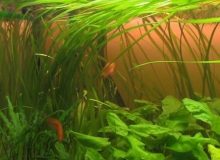
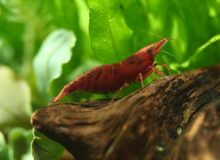
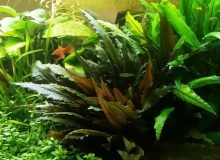
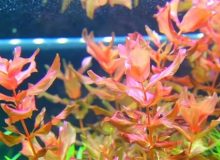
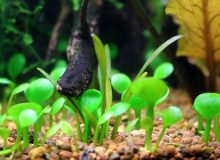
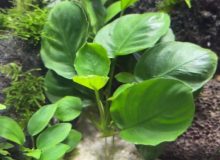
Leave a Reply